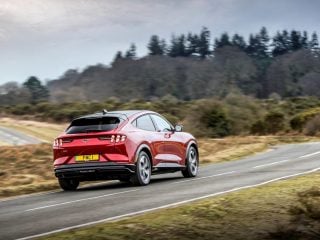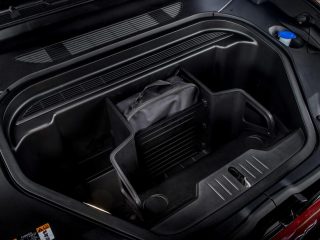Does this electric SUV bring a dose of on-road pizzazz despite its entry-level status?
In the opening months of 2021, the entry-level member of the Mustang family is no longer a sleek, slightly agro-looking two- door coupe with a heavily boosted four-pot motor at its nose. Instead, it’s this: an electric four-door SUV that Ford calls the Mustang Mach-E Standard Range RWD. Bit of a mouthful, that; and an extremely vivid sign of the times.
You’ll have formed your own opinion by now on Ford’s decision to slap that fabled pony badge and nameplate on the Mach-E, so we won’t delve into that aspect in any great detail here. But if it means that we’ll live in a world where the full-fat, big-daddy V8 Mustang is around for a few more years, then I’m on board with that call.
This particular version of the new electric Mustang is rear-driven and makes use of a single electric motor. It’s mounted at the back of the car and develops 198kW and 430Nm – enough to help this 1.9-tonne car accelerate from a standing start to 100km/h in 6.9sec.
Power comes from a 68kWh (net capacity) lithium ion battery that is housed beneath the car’s floor and is good for a WLTP-certified range of 440km. That’s about 100km less than the range-topper, and 60km less than the new Volkswagen ID 4 First Edition – but still no bad showing. DC fast charging is possible up to a maximum of 115kW.

But enough stats. On to the driving experience. The cabin is typically Ford: plain, slightly unambitious visually and finished in materials that won’t ever really be distinguished for their tactility or premium appeal. But it’s spacious and the massive portrait touchscreen looks cool, even if it can be a faff to use on the move.
Of all the new-generation EVs that have emerged at the more ‘attainable’ end of the spectrum, the Mach-E RWD is up there with the very best for the way that it drives. For starters, it feels considerably quicker than its 0-100km/h time suggests.
At least, it does between 30 and 80km/h. Pin the throttle and it takes off with fairly startling urgency, which tails off but still feels powerful as you home in on the national speed limit.
The one-pedal drive mode works really well, too. That’s good because the brake pedal itself takes some getting used to. It bites quite hard and very early on in its travel, which isn’t ideal around town or when you’re pushing things a little harder along a good road.

You’ll want to push it hard, too. Ford knows a thing or two about driver engagement and the Mustang Mach-E doesn’t come up short. True, it won’t mask its mass and size quite as effortlessly as, say, a Porsche Taycan does, but we’d never expect it to anyway. Its ride can also feel slightly lumpen at times, but it’s by no means uncomfortable and the way it handles makes up for any shortcomings here.
It steers and changes direction quite quickly, with appreciable energy and decent enough body control. Grip is good, although if you switch the traction control off, it’s possible to coax a degree of liveliness out of the rear end on the exit of a corner. This car is more fun than I thought it would be, even if you do need to warm up to it a bit.

Over the course of our 160km test route, which mixed a bit of town and motorway action with plenty of fast country roads, the Mach-E averaged 5.3km per kWh. That makes for a true real- world range of about 362km.
In fact, I’d be inclined to say that this entry-level Mustang Mach-E is probably the pick of the range.
I think it would handle in a more entertaining fashion than the heavier dual-motor car, and although the Extended Range RWD model might be able to travel further on a charge, it costs a fair amount more.
This is by no means my favourite Mustang (that would still be the V8, obviously), but I can certainly see the appeal. It’s an affordable family EV for the keen driver, for sure.
Simon Davis

















